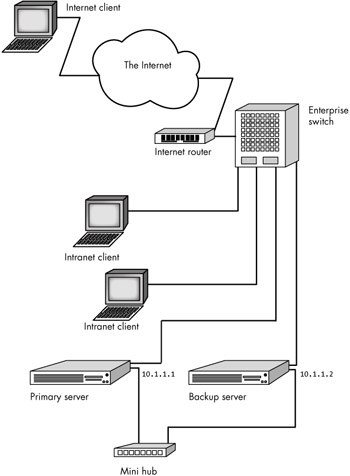Preparations
In this recipe, one of the Linux servers will be called the primary server and the other the backup server. Begin by connecting these two systems to each other using a crossover network cable, a normal network connection (through a mini hub or separate VLAN), or a null modem serial cable. (See Appendix C for information on adding NICs and connecting the servers.) We'll use the network connection or serial connection exclusively for heartbeats messages (see Figure 7-1).

Figure 7-1: The Heartbeat network configuration
If you are using an Ethernet heartbeat connection, assign IP addresses to the primary and backup servers for this network connection using an IP address from RFC 1918. For example, use 10.1.1.1 on the primary server and 10.1.1.2 on the backup server as shown in Figure 7-1. (These are IP addresses that will only be known to the primary and backup servers.)
RFC 1918 defines the following IP address ranges for "private internets":
-
10.0.0.0 to 10.255.255.255 (10/8 prefix)
-
172.16.0.0 to 172.31.255.255 (172.16/12 prefix)
-
192.168.0.0 to 192.168.255.255 (192.168/16 prefix)
In this recipe, we will use 10.1.1.1 as the primary server's heartbeat IP address and 10.1.1.2 as the secondary server's heartbeat IP address.
Before taking the following steps, be sure that you can ping between these two systems on the network connection that you added (the crossover cable or separate network connection through a mini hub/dedicated VLAN). That is, you should get a response when you enter ping 10.1.1.2 on the primary server, and ping 10.1.1.1 on the backup server. (See Appendix C if you need help.)
EAN: 2147483647
Pages: 219